Nganasan people have different sleds for men and women. The distinctive feature of a men’s one is its noiselessness: a warrior and a hunter should move without creating any noise and without attracting the attention of prey or enemy. That is why it does not have any noisy pendants: neither on the kamaryuptu — the leather belt that embraces the front deer’s chest, nor on the byniboba — the metal hook for attaching the reins. Such a hook was fastened to the kamaryupta and prevented the rope from dragging on the ground.
A byniboba for men’s harness was made either of mammoth ivory or of reindeer horn, sometimes decorated with carving. The off-wheeler reindeer was tied to a large button made of mammoth ivory or tusk, or to a belt loop; chains were not used. A women’s sled, on the other hand, had a large number of noisy pendants attached to it. The distinctive sound they made as they rode made it possible even to tell from a distance that a woman was riding.
Women’s bynibobas were of two types: the imported bronze and the special ones, which were made of iron and lavishly decorated with inlay. The latter ones had numerous rings and various pendants attached to them. On the belt of the fore reindeer on the right side, a special bow was fastened: it served for tying up the off-wheeler reindeer. Noisy pendants were also hung on it. Forged chains were often used in a sled, sometimes ringing bells and jingles were hung on reindeer’s necks.
The bronze decoration on display was designed for attaching the harness to the kamaryupta.
Taimyr Nganasans were considered the best blacksmiths among neighboring peoples, but their craft was primitive. The tools of a Nganasan blacksmith included small iron pincers, a hammer and file, and small bellows with a wooden oval bottom and top, with a leather lining on the side. The bellows were also used in blowing the fire in the fireplace. Sometimes a smith had an anvil, usually, its function was usually performed by an ax shoe. Nganasans worked directly on the hearth’s fire. Tubes, needles, hooks for pulling out meat and hooks for pipe cleaning, deer cheek plates, and chains for reindeer headbands, knives, and flints were made of iron.
More complicated everyday items that Nganasans used were mostly made in the Russian factories or by Yakut craftsmen.
A byniboba for men’s harness was made either of mammoth ivory or of reindeer horn, sometimes decorated with carving. The off-wheeler reindeer was tied to a large button made of mammoth ivory or tusk, or to a belt loop; chains were not used. A women’s sled, on the other hand, had a large number of noisy pendants attached to it. The distinctive sound they made as they rode made it possible even to tell from a distance that a woman was riding.
Women’s bynibobas were of two types: the imported bronze and the special ones, which were made of iron and lavishly decorated with inlay. The latter ones had numerous rings and various pendants attached to them. On the belt of the fore reindeer on the right side, a special bow was fastened: it served for tying up the off-wheeler reindeer. Noisy pendants were also hung on it. Forged chains were often used in a sled, sometimes ringing bells and jingles were hung on reindeer’s necks.
The bronze decoration on display was designed for attaching the harness to the kamaryupta.
Taimyr Nganasans were considered the best blacksmiths among neighboring peoples, but their craft was primitive. The tools of a Nganasan blacksmith included small iron pincers, a hammer and file, and small bellows with a wooden oval bottom and top, with a leather lining on the side. The bellows were also used in blowing the fire in the fireplace. Sometimes a smith had an anvil, usually, its function was usually performed by an ax shoe. Nganasans worked directly on the hearth’s fire. Tubes, needles, hooks for pulling out meat and hooks for pipe cleaning, deer cheek plates, and chains for reindeer headbands, knives, and flints were made of iron.
More complicated everyday items that Nganasans used were mostly made in the Russian factories or by Yakut craftsmen.



